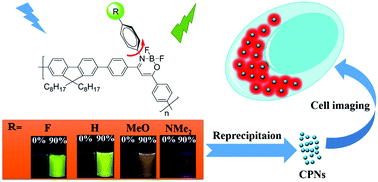A study on tunable AIE (AIEE) of boron ketoiminate-based conjugated polymers for live cell imaging†
Abstract
In this study, four boron ketoiminate-based conjugated polymers P1–P4 are designed and synthesized via Suzuki polymerization. The resulting polymers are weakly fluorescent in pure THF solutions, but become highly emissive when aggregated in THF/water mixtures or fabricated into conjugated polymer nanoparticles (CPNs), showing typical AIE (AIEE) behaviors. CPNs from P1–P4 could be prepared by reprecipitation with the particle size ranging from 85 to 95 nm. Interestingly, the tuning of the emission color of P1–P4 nanoparticles (NPs) could be conveniently accomplished by varying the substituent in the phenyl ring, which can be ascribed to the donor–acceptor interaction between the substituted phenyl ring and the boron chelating ring. The DFT theoretical calculation of the polymer repeating units indicates that the band gaps of P1–P4 can be tuned in the range 2.72–3.40 eV, suggesting that substituents in the polymer backbone have a great influence on their electronic structures and thus change AIE (AIEE) properties. Furthermore, all of the four CPNs with low cytotoxicity and high photostability could be further employed for HeLa cell imaging.


 Please wait while we load your content...
Please wait while we load your content...